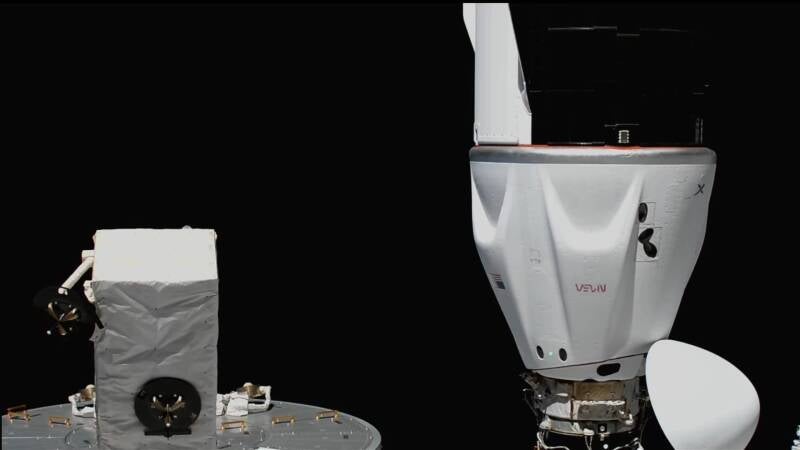In a seamless operation, SpaceX's Dragon spacecraft successfully redocked to the International Space Station (ISS) in preparation for its next cargo resupply mission. The maneuver, conducted on the morning of November 3, marked another step in SpaceX’s commitment to delivering crucial supplies, scientific equipment, and experiments to the orbiting laboratory.

The SpaceX Dragon spacecraft with four Expedition 72 crew members aboard is pictured docked to the Harmony module’s space-facing port less than an hour after undocking from Harmony’s forward port. Credit: NASA TV
The redocking maneuver involved Dragon detaching from the forward port of the ISS's Harmony module and moving to the zenith port of the same module. The SpaceX Dragon spacecraft, with Expedition 72 crew members NASA astronauts Nick Hague, Suni Williams, and Butch Wilmore, as well as Roscosmos cosmonaut Aleksandr Gorbunov, autonomously redocked with the space-facing port of the station’s Harmony module at 7:25 a.m. EST. The port relocation frees up Harmony’s forward-facing port for the 31st SpaceX commercial resupply services mission to the International Space Station. The Dragon's automated docking system guided it through the process, while the ISS crew monitored its progress closely, ready to intervene if needed. This was the fifth port relocation of a Dragon spacecraft with crew aboard following previous moves during the Crew-1, Crew-2, Crew-6, and Crew-8 missions.
The Upcoming Cargo Resupply Mission
The launch is scheduled to take place on November 5 from Kennedy Space Center’s Launch Complex 39A at 2:29 AM UTC, using a Falcon 9 rocket and the Cargo Dragon spacecraft. This mission represents the 31st ISS resupply mission by SpaceX and underscores the company’s essential role in maintaining NASA’s research and supply efforts in low Earth orbit.
A key feature of this mission is its extensive scientific payload, aimed at advancing research in neurodegenerative diseases and space technology. Among the most anticipated projects is a biomedical study that will focus on neuroinflammation, a biological process linked to diseases like Alzheimer’s and Parkinson’s. This study, developed by neuroscientists, will use three-dimensional brain cell models created from human stem cells. These models allow researchers to simulate conditions associated with these diseases, creating an unprecedented opportunity to study inflammation at a cellular level and assess potential treatment targets. Given the ISS's unique environment, scientists anticipate that results from this study could offer new insights that are challenging to obtain in terrestrial labs..
Since its first mission to the ISS in 2012, SpaceX’s Dragon spacecraft has become a crucial part of NASA’s Commercial Resupply Program (CRS). The program, which contracts private companies to deliver cargo to the ISS, has enabled the space agency to focus on deep-space exploration while leveraging private-sector expertise for near-Earth missions.
SpaceX’s role in the CRS program has also reduced NASA’s reliance on international partners and has brought a new level of frequency and flexibility to ISS operations. As Dragon continues to execute its missions efficiently, NASA and SpaceX are looking toward ambitious future projects, including lunar resupply missions as part of the Artemis program.
The successful redocking of Dragon adds another milestone to SpaceX’s achievements in space logistics and autonomous spacecraft technology. The ISS, now operational for over two decades, relies on precise planning and collaboration between multiple space agencies and private partners to stay fully functional. Dragon’s redocking and readiness for another resupply mission underscore how private-public partnerships are shaping the future of low Earth orbit operations and exploration beyond.
With SpaceX preparing for an ambitious array of future missions, including lunar landings and the eventual goal of reaching Mars, the success of each Dragon mission lays the groundwork for larger undertakings. As NASA Administrator Bill Nelson noted in a recent statement, "Every successful mission, maneuver, and docking demonstrates the potential of a new era of commercial spaceflight, which will take us beyond our limits and into new realms."
What Comes Next for Dragon?
After the upcoming cargo resupply mission, SpaceX’s Dragon will continue its rotations as part of the CRS program and is also poised to participate in crewed missions to the ISS in the future. As SpaceX refines its systems and gains more operational experience, it is likely that the Dragon spacecraft’s role will expand, carrying out increasingly complex missions to support human space exploration and further our presence in space.
For now, though, the Dragon capsule remains docked at the ISS, awaiting its next assignment as it stands ready to bring vital supplies, technology, and research material to the orbiting laboratory.


Add comment
Comments